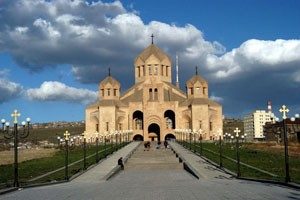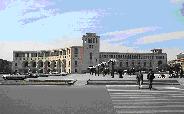Receive our newsletter
Your e-mail address is only used to send you our newsletter and information about the activities of Strasbourg Europe. You can always use the unsubscribe link included in the newsletter.
 Converted to Christianity in the late third century AD, Armenia has a long history characterized by the constant threat of invasion by foreign powers, including the Greeks, Romans, Persians, Byzantines, Mongols, Arabs, Ottomans, and Russians. As a result, there have been many struggles for power in Armenia over the centuries, especially between the Ottoman and Persian Empires. As Armenia does not have access to the sea, relations with its neighbors remain unstable. Relations with Turkey are uneasy because the events of 1915, and relations with Azerbaijan are similarly uncertain.
Converted to Christianity in the late third century AD, Armenia has a long history characterized by the constant threat of invasion by foreign powers, including the Greeks, Romans, Persians, Byzantines, Mongols, Arabs, Ottomans, and Russians. As a result, there have been many struggles for power in Armenia over the centuries, especially between the Ottoman and Persian Empires. As Armenia does not have access to the sea, relations with its neighbors remain unstable. Relations with Turkey are uneasy because the events of 1915, and relations with Azerbaijan are similarly uncertain.
© www.yerevan.am

Yerevan is one of the oldest cities in the world. One can admire an ancient inscription engraved on the stone in 782 BC, referring to the construction of a fortress called Erebuni, built by King Arghisti I, which gave its name to the city.
Capital of Armenia, located on the river Razdan, the city of Yerevan is the major economic, administrative, and scientific hub of the country. It was mentioned for the first time in the sixth century BC, yet it only became the administrative center of Eastern Armenia in 1440, before passing into the hands of the Russian Empire in 1828. Due to a history of forced migrations for the Armenian people, the city is not only the capital of the country, but also the capital for all Armenians scattered around the world. Since Armenia obtained its independence, the city of Yerevan has freed itself from the symbols of the communist regime. Names of major avenues and squares were renamed, while the statues of the heroes of the Soviet Union were taken down.
The city has evolved through several civilizations over the centuries. Yerevan houses the Matenadaran foundation, which is one of the oldest and richest libraries in the world, recognized by the “Memory of the World” UNESCO program.
Picture : Odzun church © wikimedia commons
Architecture is a very important aspect of Armenian heritage. The various civilizations in Armenia have left astounding works of architectural behind, which are recognized around the world. From the beginning of Christianity, the country experienced a new era in architecture, and temples and churches were erected that are now on UNESCO’s World Heritage List. Three sets of monuments are particuarly famous: the Cathedral and Churches of Echmiatsin and the archaeological site of Zvartnots (2000), the Monastery of Geghard and the Upper Azat Valley (2000), and the Monasteries of Haghpat and Sanahin (1996).
Picture : Odzun church © wikimedia commons
What do the colours of the Armenian flag refer to ?
An iconic symbol of Armenia, the flag has three horizontal stripes of equal width, each of which has a special meaning.
The red color at the top represents the constant struggle of the Armenian people to survive. The blue color in the middle symbolizes the will of the Armenian people to live in a peaceful environment. Finally, the yellow stripe on the bottom represents creativity and perseverance, which are considered to be the two defining characteristics of the Armenian people.
Your e-mail address is only used to send you our newsletter and information about the activities of Strasbourg Europe. You can always use the unsubscribe link included in the newsletter.
Information Center
on the European Institutions (CIIE)
Europe Direct Information Center
All rights reserved to the CIIE
Non-profit organization
Mailing address
1 allée Kastner
67000 Strasbourg
France
Visitors entrance
8 rue Boecklin
67000 Strasbourg
France
To provide the best experiences, we use technologies such as cookies to store and/or access device information. Consenting to these technologies will allow us to process data such as browsing behavior or unique IDs on this site. Failure to consent or withdrawing consent may adversely affect certain features and functions.
Europe Direct network
The CIIE team
Contact information and opening hours
Lieu d’Europe
The CIIE offices
Contact us
CIIE’s Documentation Centre & Publications
School presentations & Activities
Borrowing of learning material
Activities for the general public
Institutions of the European Union in Strasbourg
Institutions Under the Authority of the Council of Europe
Other European Organisations in Strasbourg
Sessions of the European institutions in Strasbourg
Visiting the institutions
Map of the European district of Strasbourg
Institutions in Strasbourg in photos
Discover artistic Europe
National holidays of the member states of the Council of Europe